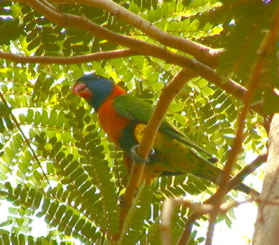THEME: Birds
SUBJECT AREA: History
TOPIC: Wildlife Exports
2001 October 17, Wednesday.
Paradise parrots, considered to be Australia’s most beautiful bird, were widely admired since the first European sightings in the nineteenth century. But, by the end of the 1920s, they were extinct. Drought and overgrazing by cattle and rabbits helped the major cause, ‘specimen collection’, to entirely wipe them out.
Early colonists were startled by the incredible colour and variety of Australia’s parrots, but felt out of place in their new country. In the 1850s, the Acclimatisation Society introduced blackbirds, thrushes, starlings, mynahs, sparrows and pigeons, among many other bird species, and European-style gardens became the fashion. Parrots were all but eliminated from the cities for more than one hundred years.

People at that time had none of the awareness of the fragility of the balance of the natural world that we have today. As new frontiers were pioneered, new flora and fauna were being discovered, thrilling times for enthusiasts. Today, we grow up with an awareness of animals such as the duck-billed platypus, and have photographs to appreciate if we cannot see them first hand.
The people of nineteenth century Western Europe had no such shock absorber to the excitement of the discovery of new species. The upper classes would pay high prices for taxidermy specimens like the Paradise Parrot, the exquisiteness of which prompted John Gould, the brilliant British naturalist, to write:
“The graceful form of this parakeet, combined with the extreme brilliance of its plumage, renders it one of the most lovely (parrots) yet discovered; and in whatever light we regard it, whether as a beautiful ornament to our cabinets, or a desirable addition to our aviaries, it is still an object of no ordinary interest.”, and: “No-one can see it without desiring to possess so beautiful and graceful a bird.”
Black Market trade of wild animals continues today all over the world, and is still contributing to the decline, and sometimes the complete elimination of floral and faunal species. Illegal bird trafficking in Australia is all too common. However, today, we are much more at home with our native species and many parrots are thriving in towns.
Suggested learning activities: Find an example of a time in history when fashions very different from today’s caused damage to the environment or an aspect of society. Research it, and discuss it with an older person (perhaps a grandparent). How do people treat this issue in modern times?
bel